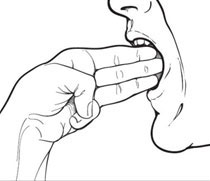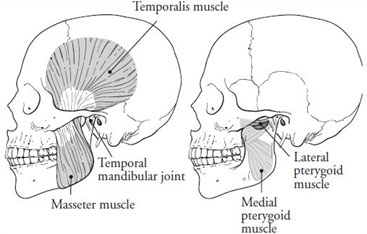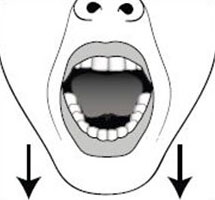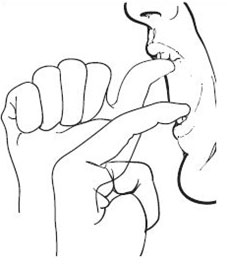Introduction
Limitation of mouth opening is also commonly known as trismus. The term trismus is defined in Taber’s Cyclopedic Medical Dictionary as a tonic contraction of the muscles of mastication. In the past, this word was often used to describe the effects of tetanus, also called ‘lock-jaw’. But, it has now been taken to represent any restriction to mouth opening.
It is a fairly common problem with many causes, which may result in difficulty in eating, talking, oral care and alteration of facial appearance. Trismus is not a disease in itself, but a symptom of another problem.
What Is The Normal Opening Of The Mouth?
The normal range of mouth opening differs from person to person, varying between 40 – 60 mm and averaging between 35 – 55 mm which is equal to the width of three fingers. It has been shown that gender may be a factor in mouth opening. In general, males display greater mouth opening.

It is also useful to understand the normal anatomy of the area around the joint of the lower jaw (mandible) with the skull. This area is known as the temporomandibular joint or TMJ. Several muscles and nerves around the jaw area work together to open and close your mouth. Any disturbance to these structures will cause trismus.

Causes Of Limitation Of Mouth Opening / Trismus
Several conditions may cause an individual to develop trismus. It is useful to divide them into the categories listed below:
- InfectionThis can be broadly separated to dental and non-dental origin. Examples of dental origin are as follows:
- Dental Caries
- Severe periodontal disease
- Infections around lower third molar
Regardless of the origin, the common result is the infection of the masticatory space (the area around the jaw opening muscles). This causes spasm of the muscles as a reaction and therefore resulting in the inability to open the mouth.
If these infections are unchecked, it can spread to various facial spaces of the head & neck and lead to serious complications such as cervical cellulitis/ mediastinitis (infection of the neck and chest).
Management involves removal of the cause (for e.g. extraction of the tooth if it’s a dental infection), prescription of appropriate antibiotics and jaw exercises once the acute infection has subsided.
-
Infection of non-dental origin can be caused by:
- Tonsil infections
- Salivary gland infections
- Brain infections
- Tetanus
-
Dental treatment
Oral surgical procedures such as extraction of lower molar teeth may cause trismus as a result either of inflammation involving the muscles of mastication (chewing) or direct trauma to the TMJ. This sometimes happens when inappropriate force is used during the extraction procedure.
Infection occuring at the site of injection especially the inferior alveolar block gives rise to trismus.
-
Trauma
Injury to the TMJ in the form of fractures can cause limited mouth opening. This is because there will be severe pain and mechanical obstruction of the lower jaw. These are corrected by reducing the fracture and immobilizing it until healing takes place.
-
TMJ disorders
These are conditions related to the inner workings of the joint. There is usually a displacement of a disc within the joint that causes clicking sounds when opening and closing the jaw, which can then lead to severe limitation of mouth opening. This is usually associated with pain around the joint region which may radiate to the temple and lower jaw as well. Treatment is usually directed at controlling the acute pain with painkillers with a course of muscle relaxants to reduce the disc displacement described earlier.
-
Tumours & Cancers
Cancers of the TMJ can also cause limitation of mouth opening. However, these are fortunately rare. A pre-cancerous condition called oral submucous fibrosis is well known to cause severe limitation of mouth opening. It has been shown to be associated with betel nut chewing which results in the formation of thick bands of fibers within the soft tissues of the mouth. Treatment would include cessation of the habit and surgery to release the bands of fibers. Squamous cell carcinoma in the posterior region of the mouth can cause trismus. Nasopharyngeal carcinoma can present with limitation in mouth opening as its first presentation.
-
Radiotherapy
Radiotherapy is commonly used to treat cancers of the mouth or head & neck. Although it preserves major structures that may have been sacrificed if surgery had been done, one of its side effects is fibrosis of the muscles that aid in opening & closing the mouth. This would therefore cause limitation in mouth opening.
Complications Of Trismus
Trismus can dramatically affect quality of life in a variety of ways. Communication is more difficult when one is suffering from trismus. Not only is it difficult to speak with the mouth partly closed, thus impairing articulation, but trismus can decrease the size of the resonating oral cavity and thus diminish vocal quality.
Severe trismus makes it difficult or impossible to insert dentures. It may make physical re-examination difficult, if limited mouth opening precludes adequate visualization of the site. Oral hygiene is compromised, chewing and swallowing is more difficult, which therefore makes eating difficult.
Treatment/Management of Trismus
Initial treatment of trismus would include identifying the causative factor and tests and investigations should be directed to identify it. However, most cases of trismus would benefit from a combination of physical therapy and mouth opening devices. If the trismus is associated with pain, the following would be beneficial :
- Heat therapyThis involves placing moist, hot towels on the affected area for 15 – 20 minutes every hour.
- Analgesics (Painkillers)For acute pain management, a course of non-steroidal anti-inflammatory drugs (NSAIDs) such as ibuprofen has been found to be beneficial.
- Soft dietStrict avoidance of hard foods such as nuts, crisps, fried foods or hard fruits (apples or pears)
- Muscle relaxantsFor certain cases a course of benzodiazepines such as diazepam or orphenadrine citrate (Norflex) has been shown to be useful in relaxing muscles under spasm
Physical therapy would involve the following active and passive jaw exercises:
Active range of motion and stretching exercises
Sit or stand. Hold your head still while doing these exercises.
- Move your jaw as described below. Hold each position for 3 seconds. Repeat 5 times.
- Open your mouth wide.
- Move your jaw to the left.
- Move your jaw to the right.
 |
 |
 |
||
- Repeat each position once more. This time stretch each for 30 seconds.
- Combine these movements to move your jaw in a circle. Open and close your mouth as you rotate your jaw left to right. Make 5 circles.
- Repeat the circle in the other direction. Make 5 circles.
Passive stretching exercises
Place one thumb on your upper teeth in the middle of your jaw. Place the pointer / (index) finger of your other hand on lower teeth in the middle of your jaw. Stretch your jaw open by pushing your bottom jaw down with pointer finger. Hold this stretch for 30 seconds.

References
- http://www.oralcancerfoundation.org/dental/trismus.htm
- http://www.toothnature.com/2011/05/trismus.html
- Dhanrajani PJ, Jonaidel O. Trismus: aetiology, differential diagnosis and treatment. Dent Update. 2002 Mar;29(2):88-92, 94.
| Last Reviewed | : | 20 March 2015 |
| Writer | : | Dr. Jeremy Lee Ju Kuan |
| Accreditor | : | Dr. Norma bt. Abd Jalil |
| Reviewer | : | Dr. Mukhriz bin Hamdan |







